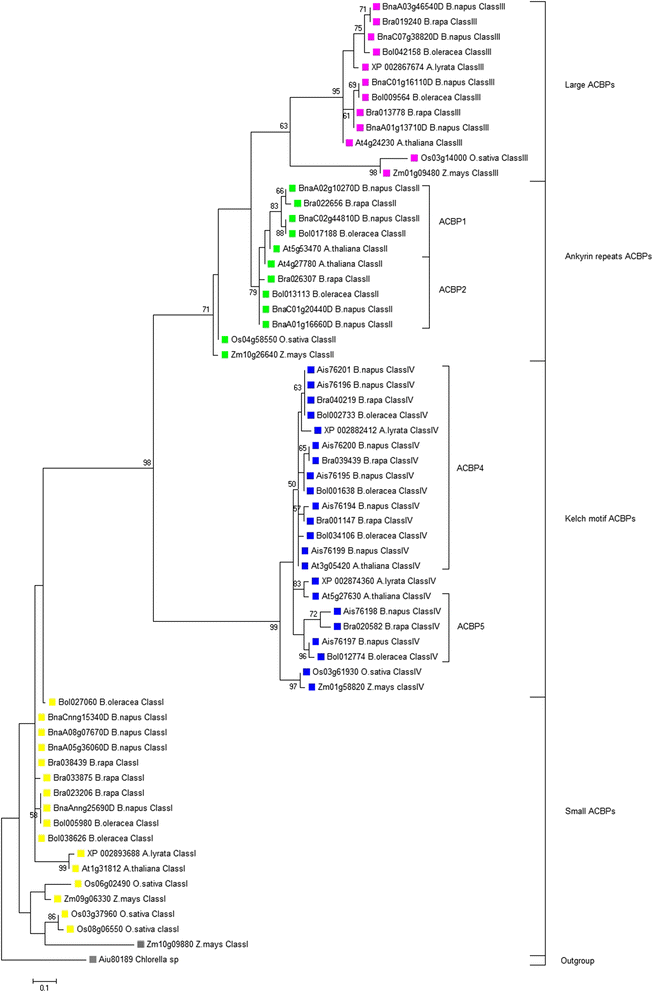Genome-wide identification and Phylogenic analysis of kelch motif containing ACBP in Brassica napus
- PMID: 26156054
- PMCID: PMC4497377
- DOI: 10.1186/s12864-015-1735-6
Genome-wide identification and Phylogenic analysis of kelch motif containing ACBP in Brassica napus
Abstract
Background: Acyl-coA binding proteins (ACBPs) bind long chain acyl-CoA esters with very high affinity. Their possible involvement in fatty acid transportation from the plastid to the endoplasmic reticulum, prior to the formation of triacylglycerol has been suggested. Four classes of ACBPs were identified in Arabidopsis thaliana: the small ACBPs, the large ACBPs, the ankyrin repeats containing ACBPs and the kelch motif containing ACBPs. They differed in structure and in size, and showed multiple important functions. In the present study, Brassica napus ACBPs were identified and characterized.
Results: Eight copies of kelch motif ACBPs were cloned, it showed that B. napus ACBPs shared high amino acid sequence identity with A. thaliana, Brassica rapa and Brassica oleracea. Furthermore, phylogeny based on domain structure and comparison map showed the relationship and the evolution of ACBPs within Brassicaceae family: ACBPs evolved into four separate classes with different structure. Chromosome locations comparison showed conserved syntenic blocks.
Conclusions: ACBPs were highly conserved in Brassicaceae. They evolved from a common ancestor, but domain duplication and rearrangement might separate them into four distinct classes, with different structure and functions. Otherwise, B. napus inherited kelch motif ACBPs from ancestor conserving chromosomal location, emphasizing preserved synteny block region. This study provided a first insight for exploring ACBPs in B. napus, which supplies a valuable tool for crop improvement in agriculture.
Figures



Similar articles
-
Computational Prediction of acyl-coA Binding Proteins Structure in Brassica napus.PLoS One. 2015 Jun 11;10(6):e0129650. doi: 10.1371/journal.pone.0129650. eCollection 2015. PLoS One. 2015. PMID: 26065422 Free PMC article.
-
The rice acyl-CoA-binding protein gene family: phylogeny, expression and functional analysis.New Phytol. 2011 Mar;189(4):1170-1184. doi: 10.1111/j.1469-8137.2010.03546.x. Epub 2010 Dec 3. New Phytol. 2011. PMID: 21128943
-
The evolution of Brassica napus FLOWERING LOCUS T paralogues in the context of inverted chromosomal duplication blocks.BMC Evol Biol. 2009 Nov 25;9:271. doi: 10.1186/1471-2148-9-271. BMC Evol Biol. 2009. PMID: 19939256 Free PMC article.
-
The binding versatility of plant acyl-CoA-binding proteins and their significance in lipid metabolism.Biochim Biophys Acta. 2016 Sep;1861(9 Pt B):1409-1421. doi: 10.1016/j.bbalip.2015.12.018. Epub 2015 Dec 31. Biochim Biophys Acta. 2016. PMID: 26747650 Review.
-
New roles for acyl-CoA-binding proteins (ACBPs) in plant development, stress responses and lipid metabolism.Prog Lipid Res. 2011 Apr;50(2):141-51. doi: 10.1016/j.plipres.2010.11.002. Epub 2010 Dec 7. Prog Lipid Res. 2011. PMID: 21144863 Review.
Cited by
-
Acyl-CoA-binding protein family members in laticifers are possibly involved in lipid and latex metabolism of Hevea brasiliensis (the Para rubber tree).BMC Genomics. 2018 Jan 2;19(1):5. doi: 10.1186/s12864-017-4419-6. BMC Genomics. 2018. PMID: 29295704 Free PMC article.
-
Overexpressing Arabidopsis thaliana ACBP6 in transgenic rapid-cycling Brassica napus confers cold tolerance.Plant Methods. 2022 May 12;18(1):62. doi: 10.1186/s13007-022-00886-y. Plant Methods. 2022. PMID: 35546678 Free PMC article.
-
Functional and Structural Diversity of Acyl-coA Binding Proteins in Oil Crops.Front Genet. 2018 May 22;9:182. doi: 10.3389/fgene.2018.00182. eCollection 2018. Front Genet. 2018. PMID: 29872448 Free PMC article. Review.
-
Genome-Wide Identification and Structural Analysis of bZIP Transcription Factor Genes in Brassica napus.Genes (Basel). 2017 Oct 24;8(10):288. doi: 10.3390/genes8100288. Genes (Basel). 2017. PMID: 29064393 Free PMC article.
-
Comparative Transcriptomics Analysis of Brassica napus L. during Seed Maturation Reveals Dynamic Changes in Gene Expression between Embryos and Seed Coats and Distinct Expression Profiles of Acyl-CoA-Binding Proteins for Lipid Accumulation.Plant Cell Physiol. 2019 Dec 1;60(12):2812-2825. doi: 10.1093/pcp/pcz169. Plant Cell Physiol. 2019. PMID: 31504915 Free PMC article.
References
Publication types
MeSH terms
Substances
LinkOut - more resources
Full Text Sources
Other Literature Sources

